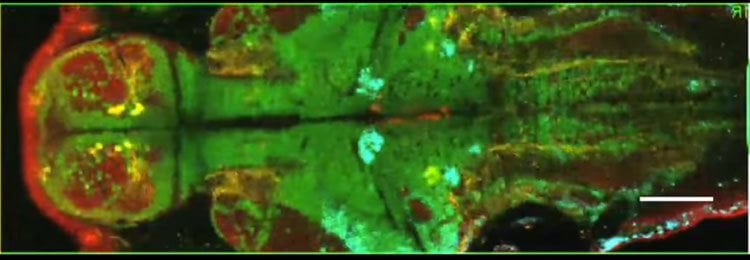Summary: Optogenetics research reveals brain circuits critical for alertness.
Source: NIH.
Using a molecular method likely to become widely adopted by the field, researchers supported by the National Institutes of Health have discovered brain circuitry essential for alertness, or vigilance – and for brain states more generally. Strikingly, the same cell types and circuits are engaged during alertness in zebra fish and mice, species whose evolutionary forebears parted ways hundreds of millions of years ago. This suggests that the human brain is likely similarly wired for this state critical to survival.
“Vigilance gone awry marks states such as mania and those seen in post-traumatic stress disorder and depression,” explained Joshua Gordon, M.D., Ph.D., director of the NIH’s National Institute of Mental Health (NIMH), which along with the National Institute on Drug Abuse, co-funded the study. “Gaining familiarity with the molecular players in a behavior – as this new tool promises – may someday lead to clinical interventions targeting dysfunctional brain states.”
Karl Deisseroth, M.D., Ph.D. (link is external), Matthew Lovett-Barron, Ph.D. (link is external), and Stanford University, Palo Alto, California, colleagues, report on findings using a neural activity screening technology they call Multi-MAP (Multiplexed-alignment of Molecular and Activity Phenotypes) online Nov. 2, 2017 in the journal Cell.

For the first time, Multi-MAP makes it possible to see which neurons are activated in a behaving animal during a particular brain state – and subsequently molecularly analyze just those neurons to identify the subtypes and circuits involved.
In this case, the researchers used the technique to screen activity of neurons visible through the transparent heads of genetically-engineered larval zebra fish. They gauged vigilance by measuring how long it took the animals to swish their tails in response to a threatening stimulus.
A molecular analysis revealing subtypes led to identification of six suspect circuits composed of distinct populations of neurons that modulate neuronal activity, only one of which had previously been linked to vigilance. Virtually the same players were operative in follow-up experiments examining such reaction time-related circuitry in mouse brain. Using optogenetics – another breakthrough exploratory tool developed by Deisseroth and colleagues — the researchers narrowed the field to three circuits that definitively boost alertness in mice, including the one previously known. The other three are thought to play a reportorial rather than regulatory role.
Grants: MH099647, DA042012
Source: NIH
Publisher: Organized by NeuroscienceNews.com.
Image Source: NeuroscienceNews.com image is adapted from the NIH/NIMH video.
Video Source: Video credited to NIH/NIMH.
Original Research: Abstract for “Ancestral Circuits for the Coordinated Modulation of Brain State” by Matthew Lovett-Barron, Aaron S. Andalman, William E. Allen, Sam Vesuna, Isaac Kauvar, Vanessa M. Burns, Karl Deisseroth in Cell. Published online November 2 2017 doi:10.1016/j.cell.2017.10.021
[cbtabs][cbtab title=”MLA”]NIH “Brain’s Alertness Circuitry Conserved Through Evolution.” NeuroscienceNews. NeuroscienceNews, 3 November 2017.
<https://neurosciencenews.com/evolution-alertness-7869/>.[/cbtab][cbtab title=”APA”]NIH (2017, November 3). Brain’s Alertness Circuitry Conserved Through Evolution. NeuroscienceNews. Retrieved November 3, 2017 from https://neurosciencenews.com/evolution-alertness-7869/[/cbtab][cbtab title=”Chicago”]NIH “Brain’s Alertness Circuitry Conserved Through Evolution.” https://neurosciencenews.com/evolution-alertness-7869/ (accessed November 3, 2017).[/cbtab][/cbtabs]
Abstract
Ancestral Circuits for the Coordinated Modulation of Brain State
Highlights
•MultiMAP: registering brain-wide cellular-resolution dynamics with molecular identity
•Diverse neuromodulatory cell types across the zebrafish brain correlate with alertness
•Neuromodulator-specific brain-state-dependent dynamics are conserved from fish to mouse
•Activation of diverse neuromodulators similarly modulates alertness-related behavior
Summary
Internal states of the brain profoundly influence behavior. Fluctuating states such as alertness can be governed by neuromodulation, but the underlying mechanisms and cell types involved are not fully understood. We developed a method to globally screen for cell types involved in behavior by integrating brain-wide activity imaging with high-content molecular phenotyping and volume registration at cellular resolution. We used this method (MultiMAP) to record from 22 neuromodulatory cell types in behaving zebrafish during a reaction-time task that reports alertness. We identified multiple monoaminergic, cholinergic, and peptidergic cell types linked to alertness and found that activity in these cell types was mutually correlated during heightened alertness. We next recorded from and controlled homologous neuromodulatory cells in mice; alertness-related cell-type dynamics exhibited striking evolutionary conservation and modulated behavior similarly. These experiments establish a method for unbiased discovery of cellular elements underlying behavior and reveal an evolutionarily conserved set of diverse neuromodulatory systems that collectively govern internal state.
“Ancestral Circuits for the Coordinated Modulation of Brain State” by Matthew Lovett-Barron, Aaron S. Andalman, William E. Allen, Sam Vesuna, Isaac Kauvar, Vanessa M. Burns, Karl Deisseroth in Cell. Published online November 2 2017 doi:10.1016/j.cell.2017.10.021






